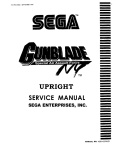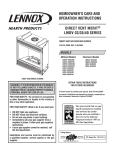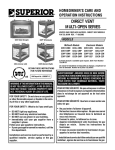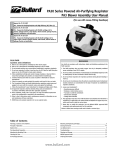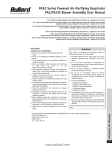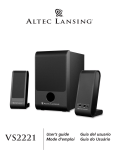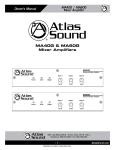Download Magnavox LSS-40CP User's Manual
Transcript
HOMEOWNER'S CARE AND OPERATION INSTRUCTIONS DIRECT VENT SPECTRA SERIES LENNOX HEARTH PRODUCTS VENTED GAS FIREPLACE HEATERS - DIRECT VENT MODELS P/N 875,020M REV. A 12/2002 MODELS LSS-35CN LSS-35CP LSS-40 MODEL SHOWN OTL Report No. 116-F-02-05 WARNING: IF THE INFORMATION IN THIS MANUAL IS NOT FOLLOWED EXACTLY, A FIRE OR EXPLOSION MAY RESULT CAUSING PROPERTY DAMAGE, PERSONAL INJURY OR LOSS OF LIFE. FOR YOUR SAFETY: Do not store or use gasoline or other flammable vapors or liquids in the vicinity of this or any other appliance. FOR YOUR SAFETY: What to do if you smell gas: • • • • DO NOT light any appliance. DO NOT touch any electrical switches. DO NOT use any phone in your building. Immediately call your gas supplier from a neighbor’s phone. Follow your gas suppliers instructions. • If your gas supplier cannot be reached, call the fire department. LSS-40CN LSS-40CP RETAIN THESE INSTRUCTIONS FOR FUTURE REFERENCE AVERTISSEMENT: ASSUREZ-VOUS DE BIEN SUIVRE LES INSTRUCTIONS DONNÉ DANS CETTE NOTICE POUR RÉDUIRE AU MINIMUM LE RISQUE D'INCENDIE OU POUR ÉVITER TOUT DOMMAGE MATÉRIEL, TOUTE BLESSURE OU LA MORT. POUR VOTRE SÉCURITÉ: Ne pas entreposer ni utiliser d'essence ni d'autre vapeurs ou liquides inflammables dans le voisinage de cet appareil ou de tout autre appareil. POUR VOTRE SÉCURITÉ: Que faire si vous sentez une odeur de gaz: • Ne pas tenter d'allumer d'appareil. • Ne touchez à aucun interrupteur. Ne pas vous servir des téléphones se trouvant dans le batiment où vous vous trouvez. • Evacuez la piéce, le bâtiment ou la zone. • Appelez immédiatement votre fournisseur de gaz depuis un voisin. Suivez les instructions du fournisseur. • Si vous ne pouvez rejoindre le fournisseur de gaz, appelez le service dos incendies. Installation and service must be performed by a L'installation et service doit être exécuté par un qualifié qualified installer, service agency or the gas installeur, agence de service ou le fournisseur de gaz. supplier. NOTE: DIAGRAMS & ILLUSTRATIONS NOT TO SCALE. 1 CONGRATULATIONS! GENERAL INFORMATION In selecting this LENNOX Signature Series Direct-Vent Gas Appliance you have chosen the finest and most dependable fireplace to be found anywhere. A beautiful, prestigious, alternative to a wood burning fireplace. Welcome to a Family of tens of thousands of satisfied LENNOX Fireplace Owners. Note: Installation and repair should be performed by a qualified service person. The appliance should be inspected annually by a qualified professional service technician. More frequent inspections and cleanings may be required due to excessive lint from carpeting, bedding material, etc. It is imperative that the control compartment, burners and circulating air passage ways of the appliance be kept clean. Please read and carefully follow all of the instructions found in this manual. Please pay special attention to the safety instructions provided in this manual. The Homeowner's Care and Operation Instructions included here will assure that you have many years of dependable and enjoyable service from your LENNOX product. TABLE OF CONTENTS Introduction ..................................... page 2 General Information ......................... page 2 Operation/Care of Your Appliance .... page 3 RF Comfort Control Valve Operation page 3 Transmitter Operation ...................... page 4 Trouble shooting ............................. page 5 Glass Cleaning ................................. page 6 Maintenance .................................... page 6 Maintenance Schedule ..................... page 7 Front Glass Enclosure Panel, Removal and Installation ............... page 8 Burner Adjustments ......................... page 8 Flame Appearance and Sooting ....... page 8 Adjustment ...................................... page 9 Vent Restrictor ................................ page 9 Log Placement ................................. page 10 Rockwool Placement ....................... page 11 Pilot Inspection ............................... page 11 Warranty .......................................... page 11 Replacement Parts .......................... page 11 These appliances feature a comfort control valve which allows remote control of temperature, fan and flame appearance. These appliances also use a spark ignitor (piezo) that allows the appliance's pilot gas to be lit without the use of matches. This system provides continued service in the event of a power outage. The external electrical power (120v) is required to operate the provided circulating blower. These appliances comply with National Safety Standards and are tested and listed by OmniTest Laboratories (Report No. 116-F-02-5) to ANSI Z21.88-2002 (in Canada, CSA-2.33-2002), and CAN/CGA-2.17-M91 in both USA and Canada, as vented gas fireplace heaters. The Installation must conform to local codes or, in the absence of local codes, with the National Fuel Gas Code, ANSI Z223.1/NFPA 54, or the Natural Gas and Propane Installation Code, CSA B149.1. The appliance, when installed, must be electrically grounded in accordance with local codes or, in the absence of local codes, with the National Electrical Code, ANSI/NFPA 70, or the Canadian Electrical Code, CSA C22.1. Product Reference Information ....... page 11 Accessory Components ................... page 12 Replacement Parts List ..................... page 14 INTRODUCTION The Fireplace models covered in this manual are Direct-Vent sealed combustion vented gas fireplace heaters designed for residential application. Direct-Vent appliances operate with the combustion chamber completely isolated from the inside atmosphere. All air for combustion is brought in from the outside and exhaust gases are vented through the same direct vent, vent system. 2 DO NOT ATTEMPT TO ALTER OR MODIFY THE CONSTRUCTION OF THE APPLIANCE OR ITS COMPONENTS. ANY MODIFICATION OR ALTERATION MAY VOID THE WARRANTY, CERTIFICATION AND LISTINGS OF THIS UNIT. WARNING: IMPROPER INSTALLATION, ADJUSTMENT, ALTERATION, SERVICE OR MAINTENANCE CAN CAUSE INJURY OR PROPERTY DAMAGE. REFER TO THIS MANUAL. FOR ASSISTANCE OR ADDITIONAL INFORMATION CONSULT A QUALIFIED INSTALLER, SERVICE AGENCY OR THE GAS SUPPLIER. NOTE: DIAGRAMS & ILLUSTRATIONS NOT TO SCALE. S'assurer que le brùleur et le compartiment des commandes sont propres. Voir les instructions d'installation et d'utilisation qui accompagnent l'appareil. Provide adequate clearances around air openings and adequate accessibility clearance for service and proper operation. Never obstruct the front openings of the appliance. Due to high temperatures the appliance should be located out of traffic and away from furniture and draperies. Locate furniture and window coverings accordingly. WARNING: THESE FIREPLACES ARE VENTED HEATERS. DO NOT BURN WOOD OR OTHER MATERIAL IN THESE APPLIANCES. These appliances are designed to operate on natural or propane gas only. Input of millivolt models is variable. These rates are shown in the following table: Model Fuel Maximum Input (BTU/H) Minimum Input (BTU/H) LSS-35CN Nat. Gas 33,000 23,500 LSS-35CP LP Gas 31,000 23,500 LSS-40CN Nat. Gas 41,500 28,400 LSS-40CP LP Gas 39,000 30,700 The following table shows the units' orifice size for the elevations of 0-4500 feet (0-1370 meters). Model Fuel Rear Burner Front Burner LSS-35CN Nat. Gas #44 #50 LSS-35CP LP Gas #55 #61 LSS-40CN Nat. Gas #42 #45 LSS-40CP LP Gas 0.054" #56 Maximum manifold pressure is 3.5 in. w.c. (0.87 kPa) for natural gas and 10 in. w.c. (2.49 kPa) for LP/Propane gas. Do not use these appliances if any part has been under water. Immediately call a qualified, professional service technician to inspect the appliance and to replace any parts of the control system and any gas control which have been under water. Ne pas se servir de cet appareil s'il a été plongé dans l'eau, complètement ou en partie. Appeler un technicien qualifié pour inspecter l'appareil et remplacer toute partie du système de contrôle et toute commande qui ont été plongés dans l'leau. Test gage connections are provided on the front of the millivolt gas control valve (identified OUT for the manifold side and IN for inlet pressure. Minimum inlet gas pressure to these appliances is 5.0 inches water column (1.24 kPa) for natural gas and 11 inches water column (2.74 kPa) for propane for the purpose of input adjustment. Maximum inlet gas supply pressure to these appliances is 10.5 inches water column (2.61 kPa) for natural gas and 13.0 inches water column (3.23 kPa) for propane. The appliance must be isolated from the gas supply piping system (by closing its individual manual shut-off valve) during any pressure testing of the gas supply piping system at test pressures equal to or less than ¹⁄₂ psig (3.5 kPa). The appliance and its individual shut-off valve must be disconnected from the gas supply piping system during any pressure testing of that system at pressures in excess of ¹⁄₂ psig (3.5 kPa). These appliances must not be connected to a chimney or flue serving a separate solid fuel burning appliance. Any safety guard or screen removed for servicing the appliance must be replaced prior to operating the appliance. WARNING: FAILURE TO COMPLY WITH THE INSTALLATION AND OPERATING INSTRUCTIONS PROVIDED IN THIS DOCUMENT WILL RESULT IN AN IMPROPERLY INSTALLED AND OPERATING APPLIANCE, VOIDING ITS WARRANTY. ANY CHANGE TO THIS APPLIANCE AND/OR ITS OPERATING CONTROLS IS DANGEROUS. IMPROPER INSTALLATION OR USE OF THIS APPLIANCE CAN CAUSE SERIOUS INJURY OR DEATH FROM FIRE, BURNS, EXPLOSION OR CARBON MONOXIDE POISONING. Carbon Monoxide Poisoning: Early signs of carbon monoxide poisoning are similar to the flu with headaches, dizziness and/or nausea. If you have these signs, obtain fresh air immediately. Turn off the gas supply to the appliance and have it serviced by a qualified professional, as it may not be operating correctly. WARNING: CHILDREN AND ADULTS SHOULD BE ALERTED TO THE HAZARDS OF HIGH SURFACE TEMPERATURES. USE CAUTION AROUND THE APPLIANCE TO AVOID BURNS OR CLOTHING IGNITION. YOUNG CHILDREN SHOULD BE CAREFULLY SUPERVISED WHEN THEY ARE IN THE SAME ROOM AS THE APPLIANCE. WARNING: DO NOT PLACE CLOTHING OR OTHER FLAMMABLE MATERIALS ON OR NEAR THIS APPLIANCE. AVERTISSEMENT: SURVEILLER LES ENFANTS. GARDER LES VÊTEMENTS, LES MEUBLES, L'ESSENCE OU AUTRES LIQUIDES À VAPEUR INFLAMMABLES LOIN DE L'APPAREIL. OPERATION AND CARE OF YOUR APPLIANCE For piezo ignitor location, refer to Figure 1. The control compartment is located behind the bottom front face piece. For access: In the Cast Iron Face accessory - simply lift up and pull directly out. Honeywell Gas Valve Piezo Ignitor Honeywell RF Control Millivolt Gas Valve Showing Piezo Ignitor Location Figure 1 INSTRUCTIONS FOR RF COMFORT CONTROL VALVE The Comfort Control Valve allows remote control of temperature, fan and flame appearance. Note: The antenna should hang in free air and away from any grounded metal. Operation (refer to Figure 2, page 4 ) Step 1. If the manual switch is in the remote position, switch it to LOCAL. Step 2. Turn the Pilotstat knob counterclockwise from OFF to the PILOT position, push the knob down and hold it in position. The pilot valve will open and allow gas to flow to the pilot burner. Step 3. Actuate the plunger on the piezo (several times if necessary) until the pilot burner is lit. When the pilot burner is lit, the LED on the control will come on after approximately 40 seconds. The receiver/valve is fully powered. Step 4. Release the knob. The shaft will move forward. The pilot burner should now stay burning. If the pilot burner goes out, repeat Steps 2 and 3. Step 5. Turn the knob counterclockwise to the ON position. If the manual switch is in the LOCAL position, the main burner will turn on immediately. In the Rectangular or Arched Face accessory Pivot the main face door (bottom) on the two hinge pins, and drop down to open. NOTE: DIAGRAMS & ILLUSTRATIONS NOT TO SCALE. 3 Step 6. ON the initial use of a transmitter, a recognition operation is required between the receiver/valve and transmitter. Change the switch from LOCAL to REMOTE. Press the fan or flame button on the transmitter within 30 seconds. The LED will blink indicating the transmitter will now work with the receiver/valve. If the switch continues in the REMOTE position, the transmitter will now control the main valve, flame modulation level and fan control. Screw Cap Of Pilot Adjustment Step 7. If the manual switch is in the LOCAL position, the valve will be at the highest fixed pressure setting. The transmitter will control the fan only. Shut Off Procedure Local/Remote Switch Pilotstat Knob Display - Room Temperature - Set Temperature - Flame Height Level - Fan Speed Level - Countdown Timer - Low Battery To shut off the system, turn the pilotstat knob clockwise to the OFF position. This action closes the main gas and safety valves. The transmitter now cannot turn on the main burner or fan. Mode - Auto - On - Off TRANSMITTER OPERATION (refer to Figure 3 ) Countdown Timer Off Mode On (Manual) Mode In the ON mode, the room temperature, flame and fan levels will be shown. MANUAL will appear next to both the flame and fan icons. When the control is in the ON mode, the flame and fan levels, and the delay timer are changed with the up and down buttons. To change the flame level, press the flame button followed by an arrow key. To change the fan level, press the fan key followed by an arrow key. Pushing the arrow key once will change the level by one unit. Delay Timer Mode The shut off delay timer has a maximum of 2 (two) hours and a minimum of 0 (zero) minutes. To change the timer level, press the time key followed by an arrow key. Pushing the key once will change the timer by 10 (ten) minutes. 4 Antenna LED Figure 2 If the manual switch is in the REMOTE position, the transmitter can shut off the main burner and fan. However, the control is still on and a command from the transmitter can turn on the main burner or fan. In the OFF mode, the fireplace flame and fan are off, the display will show OFF and displays the room temperature. If the receiver is in REMOTE mode, the fireplace will shut off. Piezo Ignitor Fan Flame Up (Increases Flame Height, Fan Speed Timer, or Set Point) Down (Decreases Flame, Fan Speed Timer, or Set Point) Figure 3 Auto Mode Fan Override During Auto Mode In the AUTO mode, the room temperature, set temperature, flame and fan levels will be shown. AUTO will appear next to both the flame and fan icons. If a lower or higher fan speed is desired when operating in the AUTO mode, the fan speed can be overridden by pushing the fan button followed by the up or down key. When the control is in the AUTO mode, the main burner will turn on/off or modulate based on the heat needed to maintain the set temperature. The flame level will change automatically to optimize the heat output needed to maintain the set temperature. To change the set temperature, press the up or down key. Pushing a key once will change the temperature by 1 (one) degree. The setting temperature range from 40° F (4.5° C) to 90° F (32.0° C). Pushing a key once will change the fan level by one unit. In this mode "AUTO" is displayed next to the flame icon and "MANUAL" is displayed next to the fan icon. In the AUTO mode, the fan speed will increase with increasing flame height or decrease with decreasing flame height. "AUTO" is displayed next to the flame and fan icons. Disable Thermostat Function NOTE: DIAGRAMS & ILLUSTRATIONS NOT TO SCALE. Change Between F/C Temperature Units Push the up and down arrow keys simultaneously for at least 3 seconds to toggle between Fahrenheit and Celsius units. To disable the thermostat function in the AUTO mode, push the time and down key simultaneously for at least 3 seconds. To Change Batteries If an Error Code 3 is observed while performing the testing, complete the following: 1. Remove cover on the backside of the transmitter. Install 3 AAA batteries as shown inside the cover and reattach the cover. 2. Once steps 1 thru 3 in OPERATION are completed, receiver/valve and transmitter are now ready. Press any button on transmitter for recognition precess to occur between the receiver/valve and transmitter. 3. Use functions as described in TRANSMITTER section. Troubleshooting Step 1. Make sure the spade connectors are pushed all the way on. If the Error Code 3 is still showing, then go to the next step. Step 2. Switch the front two thermopile leads with the back two. Be sure the lead is connected to the spade with the white dot next to it (see Figure 4 ). If the Error Code 3 is still showing, replace the thermopiles. If an Error Code 8 is observed while performing the testing, complete the following: Step 1. Confirm that the valve is not in REMOTE mode. Step 1. Locate LED light on valve. Step 2. LED will blink after every valid command received by the transmitter; this is not an error. Step 3. Failure codes may occur anytime after pilot burner is lit. Step 4. Sequence is failure code followed by light not blinking for 4 seconds. Step 5. In the event of multiple failure codes, next failure code follows previous failure code by approximately 3 seconds • If the valve is producing Error Code 8 and in REMOTE mode, the valve is defective and should be replaced. LED Failure Code (Number Of Blinks) Service Action 8 Replace valve 7 Confirm stepper motor connection exists 5 Confirm fan connection exists and works 4 Confirm gas type; jumper in place 3 Replace thermopiles 2 Turn fan ON 1 No action required NOTE: Some keys are not active. This is normal. • If the valve is in LOCAL mode and producing Error Code 8, then go to the next step. Step 2. Slide the Remote/Local switch to REMOTE and reprogram valve recognition (refer to in Operation section). The Error Code will clear itself after approximately 1 1/2 minutes and return to normal operation. COMFORT VALVE WIRING DIAGRAM AUTO PATH DIAGRAM CAUTION: LABEL ALL WIRES PRIOR TO DISCONNECTION WHEN SERVICING CONTROLS. WIRING ERRORS CAN CAUSE IMPROPER AND DANGEROUS OPERATION. VERIFY PROPER OPERATION AFTER SERVICING. BLOWER BLACK F M BLACK WHITE GREEN GREEN F M WHITE F F White Dots VALVE RED WHITE RED Figure 4 WHITE NOTE: DIAGRAMS & ILLUSTRATIONS NOT TO SCALE. Figure 5 5 Glass Cleaning Comfort Valve System Control Sequence Of Operation With Transmitter It will be necessary to clean the glass periodically. During start-up it is normal for condensation to form on the inside of the glass. This can cause lint, dust and other airborne particles to cling to the glass surface. Also initial paint curing may deposit a slight film on the glass. It is therefore recommended that the glass be cleaned two or three times with a nonammonia household cleaner and warm water (a gas fireplace glass cleaner is recommended). After that the glass should be cleaned two or three times during each heating season, depending on the circumstances present. Note: Clean glass after first two weeks of operation at least once. In some environments, it may be necessary to clean the glass several times during the first weeks of operation. WARNING: DO NOT USE ABRASIVE CLEANERS. NEVER CLEAN THE GLASS WHEN IT IS HOT. CAUTION: DO NOT ATTEMPT TO TOUCH THE FRONT ENCLOSURE GLASS WITH YOUR HANDS WHILE THE FIREPLACE IS IN USE. Maintenance The appliance and venting system should be thoroughly inspected before initial use and at least annually by a qualified service technician. However, more frequent periodic inspections and cleanings should be performed by the homeowner. Homeowner must contact a qualified service technician at once if any abnormal condition is observed. Refer to the maintenance schedule for maintenance tasks, procedures, periodicity and by whom they should be performed. Always verify proper operation of the appliance after servicing. Figure 6 IMPORTANT: TURN OFF GAS AND ANY ELECTRICAL POWER BEFORE SERVICING THE APPLIANCE. 6 NOTE: DIAGRAMS & ILLUSTRATIONS NOT TO SCALE. Maintenance Schedule Annually (Before the onset of the Burning Season) Maintenance Task Accomplishing Person Procedure Inspecting/Cleaning Burner, Logs and Controls Qualified Service Technician Inspect valve and ensure it is properly operating. Check piping for leaks. Vacuum the control compartment, fireplace logs and burner area. Check Flame Patterns and Flame Height Qualified Service Technician Refer to Figure 9 (LSS-35),or Figure 10 (LSS-40) on page 10 and verify the flame pattern and height displayed by the appliance conforms to the picture. Flames must not impinge on the logs. Inspecting/Cleaning Pilot and Burner Qualified Service Technician Refer to Figure 11 on page 11. Remove any surface build-up on pilot and burner assembly. Wipe the pilot nozzles, ignitor/flame rod and hood. Ensure the pilot flame engulfs the flame sensor as shown. Checking Vent System Qualified Service Technician Inspect the vent system at the top and at the base (within the firebox) for signs of blockage or obstruction. Look for any signs of dislocation of the vent components. Do not adjust the vent restrictor adjustment rod. Appliance Checkout Qualified Service Technician Perform the appropriate appliance checkout procedure detailed in this manual. Replacing Rockwool Ember Materials Homeowner/Qualified Services Technician Remove old ember materials. Place new rockwool as described in this document. Accomplishing Person Procedure Periodically (After the Burning Season) Maintenance Task Check Flame Patterns and Flame Height Homeowner Refer to Figure 9 (LSS-35), or Figure 10 (LSS-40) on page 10 and verify the flame pattern and height displayed by the appliance conforms to the picture. Flames must not impinge on the logs. Checking Vent System Homeowner Inspect the vent system at the top and at the base (within the firebox) for signs of blockage or obstruction. Look for any signs of dislocation of the vent components. Cleaning Front Glass Enclosure Panel Homeowner Clean as necessary following the directions provided in this manual. DO NOT TOUCH OR ATTEMPT TO CLEAN GLASS WHILE HOT. NOTE: DIAGRAMS & ILLUSTRATIONS NOT TO SCALE. 7 Front Glass Enclosure Panel, Removal and Installation. Refer to Figure 7 and remove the front glass enclosure panel as follows: WARNING: NEVER OPERATE THE APPLIANCE WITHOUT THE GLASS ENCLOSURE PANEL IN PLACE AND SECURE. DO NOT OPERATE APPLIANCE WITH THE FRONT GLASS PANEL CRACKED, BROKEN OR MISSING. REPLACEMENT PANELS ARE AVAILABLE THROUGH YOUR LOCAL LENNOX DEALER AND MUST BE INSTALLED BY A LICENSED OR QUALIFIED SERVICE TECHNICIAN. 1. Remove the cast iron, arched or rectangular face kit. 2. Lift the bottom piece up and pull directly out. Burner Adjustments These are direct-vent appliances. They are designed to operate only with the front glass enclosure panel properly installed. Generally, the glass enclosure panel should not be removed except to gain access to the components within the firebox, and the appliance may only be operated without the front glass enclosure panel in place for very brief periods of time during initial appliance checkout and adjustment. 3. Lift the side pieces up and pull directly out. The following paragraphs address burner adjustment concerns and procedures. During this appliance checkout and adjustment period, a potential safety hazard exists - EXERCISE EXTREME CAUTION to prevent the occurrence of any burn injuries from the exposed flames or hot surfaces. Also note, that while the front glass enclosure panel is removed, the flame appearance will appear to be smaller than normal. 3. Swing the bottom of the door out and raise it slightly to lift the top flange of the door frame away from the appliance. WARNING: HANDLE THE GLASS WITH EXTREME CARE! TEMPERED GLASS IS SUSCEPTIBLE TO DAMAGE (SCRATCHES, FOR EXAMPLE) – HANDLE GLASS DOOR (GLASS ENCLOSURE PANEL) GENTLY WHILE REINSTALLING IT. WARNING: NO NOT ATTEMPT TO SUBSTITUTE THE MATERIALS USED ON THIS DOOR, OR REPLACE CRACKED OR BROKEN GLASS WITH ANY MATERIALS OTHER THAN THOSE PROVIDED BY THE APPLIANCE MANUFACTURER. WARNING: DO NOT OPERATE APPLIANCE WITH THE GLASS FRONT REMOVED, CRACKED OR BROKEN. REPLACEMENT OF THE GLASS SHOULD BE DONE BY A LICENSED OR QUALIFIED SERVICE PERSON. 8 CAUTION: DO NOT ATTEMPT TO REMOVE UNTIL THE FACEPLATE IS COOL. A) Cast Iron Face Kit: 1. Lift the top arched piece up and pull directly out. B) Arched or Rectangular Face Kit: 1. Lift the face assembly up and pull directly out. 2. Locate the two (2) latches at the top of the control compartment and disengage them from the door frame's bottom Vee-flange, pulling down on their handles to open them. Top Flange Door Frame Vent Restrictor Adjustment Rod Glass Door Latch 2. Position the door frame in front of the firebox opening and engage the top flange over the lip at the top of the firebox opening. 3. Swing the door down and back. Ensure the gasket seats evenly as the door draws shut. Engage the Vee-flange at the bottom of the door with the latches and close the latches to secure the door. 4. Hook the cast iron, arched or rectangular facade onto the face of the fireplace. Flame Appearance and Sooting Proper flame appearance is a matter of taste. Generally most people prefer the warm glow of a yellow to orange flame. Appliances operated with air shutter openings that are too large will exhibit flames that are blue and transparent. These weak, blue and transparent flames are termed anemic. If the air shutter opening is too small sooting may develop. Sooting is indicated by black puffs developing at the tips of very long orange flames. Sooting results in black deposits forming on the logs, appliance inside surfaces and on exterior surfaces adjacent to the vent termination. Sooting is caused by incomplete combustion in the flames and a lack of combustion air entering the air shutter opening. To achieve a warm yellow to orange flame with an orange body that does not soot, the shutter opening must be adjusted between these two extremes. No smoke or soot should be present. Reposition the logs if the flames impinge on any of them. Bottom Vee-flange Door Frame Latch Firebox Floor Figure 7 If the logs are properly positioned and sooting conditions exist, the air shutter opening on the main burner tube should be adjusted. Normally, the more offsets in the vent system, the greater the need for the air shutter to be opened further. To install the front glass enclosure panel, proceed as follows: WARNING: AIR SHUTTER ADJUSTMENT SHOULD ONLY BE PERFORMED BY A QUALIFIED PROFESSIONAL SERVICE TECHNICIAN. 1. Retrieve the glass door frame. Visually inspect the gasket on the backside of the panel. The gasket surface must be clean, free of irregularities and seated firmly. ENSURE THAT THE FRONT GLASS PANEL IS IN PLACE AND SEALED DURING ADJUSTMENT. NOTE: DIAGRAMS & ILLUSTRATIONS NOT TO SCALE. Adjustment Vent Restrictor Burner Venturi Tube CAUTION: THE AIR SHUTTER ADJUSTMENT ROD (SEE FIGURE 8 ) AND NEARBY APPLIANCE SURFACES ARE HOT. EXERCISE CAUTION TO AVOID INJURY WHILE ADJUSTING FLAME APPEARANCE. To adjust the flame, restate the air shutter adjustment rod toward the back or toward the front of the fireplace (rod located in the lower control area). Position the air shutter to the factory setting as shown in the Table of Figure 8. Allow the burner to operate for at least 15 minutes. Observe the flame continuously. If it appears weak or sooty as previously described, adjust the air shutter by pushing or pulling on the adjustment rod until the flame appearance is as desired. Air Shutter Opening Air Shutter Door Orifice Air Shutter Adjusting Rod The air shutter adjustment rod and associated adjustable air shutter is patented technology. Flame adjustments can be made quickly and accurately to taste without the need of disassembling the appliance and waiting for 30 minutes after each adjustment. Propane models may exhibit a flame pattern that may candle or appear stringy. If this is problematic or persists as the appliance is continually operated, adjust the air shutter closed as described in the previous paragraphs. Operate the appliance for a period of time as the effect diminishes, ensuring that the appliance does not develop sooty flames. The appliance has a built-in vent restrictor, refer to Figure 7, page 8 for location, to adjust the flow of exhaust gases. This ensures proper combustion for all vent configurations. Depending on the vent configuration, you may be required to adjust the restriction position. See below for guidelines. CAUTION: THE FIREPLACE NEEDS TO BE ON DURING THE ADJUSTMENT OF THE VENT RESTRICTOR. USE A GLOVE TO PROTECT YOUR HAND FROM BURNS. Venting Configuration Adjustment Rod Position 1. Horizontal Venting with 6" vent section and one 90° elbow. * Pointed toward 2. Vertical venting. Models LSS-35 LSS-40 Gas Type FACTORY AIR SHUTTER SETTING OPENING inches (mm) Nat. Prop. Nat. Prop. 1/2 (13.0) 5/8 (15.8) 1/2 (13.0) 5/8 (15.8) 3. Combination of vertical and horizontal venting. the front. * Pointed toward the left. * Adjust accordingly for best result. * Adjustment to the air shutter may be required to get the desired flame appearance, (refer to Figure 8 ). Figure 8 When satisfied that the appliance operates properly, proceed to finish the installation. Leave the control knob in “ON” position and turn the remote switch “OFF.” Close the lower control compartment door. NOTE: DIAGRAMS & ILLUSTRATIONS NOT TO SCALE. 9 Log Placement WARNING: LOGS GET VERY HOT AND WILL REMAIN HOT UP TO ONE HOUR AFTER GAS SUPPLY IS TURNED OFF. HANDLE ONLY WHEN LOGS ARE COOL. TURN OFF ALL ELECTRICITY TO THE APPLIANCE BEFORE YOU INSTALL GRATE AND LOGS. WARNING: THE SIZE AND POSITION ON THE LOG SET WAS ENGINEERED TO GIVE YOUR APPLIANCE A SAFE, RELIABLE AND ATTRACTIVE FLAME PATTERN. ANY ATTEMPT TO USE A DIFFERENT LOG SET IN THE FIREPLACE WILL VOID THE WARRANTY AND WILL RESULT IN INCOMPLETE COMBUSTION, SOOTING, AND POOR FLAME QUALITY. Figure 9 MODEL LSS-35 Figure 10 MODEL LSS-40 WARNING: THIS APPLIANCE IS NOT MEANT TO BURN WOOD. ANY ATTEMPT TO DO SO COULD CAUSE IRREPARABLE DAMAGE TO YOUR APPLIANCE AND PROVE HAZARDOUS TO YOUR SAFETY. Carefully position the ceramic fiber logs over the burner as shown in Figure 9 (LSS-35) or Figure 10 (LSS-40). For more detailed placement instructions, refer to the LOG PLACEMENT GUIDE accompanying this document. Proper log placement is critical to prevent sooting. Logs should be placed in the gaps between the flame peaks and should be positioned so that at no time they impinge the flames. 10 NOTE: DIAGRAMS & ILLUSTRATIONS NOT TO SCALE. Glowing Embers (Rockwool) Placement Refer to the detailed glowing embers placement instructions provided in the LOG PLACEMENT GUIDE accompanying this document. Honeywell RF Control Millivolt Appliance Pilot Checkout To adjust pilot burner; (by a qualified service technician) 1. Remove pilot adjustment cap. ³⁄₈" Min (9 mm) 2. Adjust pilot screw to provide properly sized flame. 3. Replace pilot adjustment cap. Pilot Inspection To obtain proper operation, it is imperative that the pilot and burner's flame characteristics are steady, not lifting or floating (see Figure 11 ). MILLIVOLT HONEYWELL The primary air shutter is set at the factory and should only be adjusted, if necessary, by a qualified service technician. Thermopile Ignitor Rod Hood ³⁄₈" Min (9 mm) Pilot Nozzels Thermopile Figure 11 Typically, the top 3/8" of the thermopile should be engulfed in the pilot flame (Figure 11 ). WARRANTY Your gas appliance is covered by a limited twenty year warranty. You will find a copy of the warranty accompanying this manual. Please read the warranty to be familiar with its coverage. Retain this manual. File it with your other documents for future reference. REPLACEMENT PARTS A complete parts list is found at the end of this manual. Use only parts supplied from the manufacturer. Normally, all parts should be ordered through your Lennox distributor or dealer. Parts will be shipped at prevailing prices at time of order. When ordering repair parts, always give the following information: 1. The model number of the appliance. 2. The serial number of the appliance. 3. The part number. 4. The description of the part. 5. The quantity required. 6. The installation date of the appliance. If you encounter any problems or have any questions concerning the installation or application of this system, please contact your distributor, or Lennox directly: LHP 1110 West Taft Avenue Orange, CA 92865 PRODUCT REFERENCE INFORMATION We recommend that you record the following important information about your fireplace. Please contact your Lennox dealer for any questions or concerns. For the number of your nearest Lennox dealer, please call 800-731-8101 Your Fireplace's Model Number _______________________________________ Your Fireplace's Serial Number ________________________________________ The Date On Which Your Fireplace Was Installed __________________________ The Type of Gas Your Fireplace Uses ___________________________________ Your Dealer's Name _________________________________________________ NOTE: DIAGRAMS & ILLUSTRATIONS NOT TO SCALE. 11 ACCESSORY COMPONENTS Cast Iron Kits Model Series Catalog No. Model No. LSS-35 H0378 LSS-CA35 LSS-40 H0398 LSS-CA40 Cast Iron Kits These cast iron face kits are designed to be used in conjunction with the grillwork kits. Together, when installed, these kits complete the front aspect of the Spectra LSS Series gas fireplaces. A detailed set of instructions (P/N 750,150M) is included with each kit. Touch-Up Paint (Black) Kit 90L73 FTPK-B Touch-Up Paint Kit Grillwork Kits (Top & Bottom) Model Series Finish Catalog No. Model No. LSS-35 Black Gold Nickel H0379 H0380 H0381 LSS-GB35 LSS-GG35 LSS-GN35 LSS-40 Black Gold Nickel H0399 H0400 H0404 LSS-GB40 LSS-GG40 LSS-GN40 Grillwork Kits (Top & Bottom) These grillwork kits are designed to be used in conjunction with the Cast Iron Face kits. Together, when installed, these complete the front aspect of the Spectra LSS Series gas fireplace. A detailed set of instructions (P/N 750,151M) is included with each kit. 12 NOTE: DIAGRAMS & ILLUSTRATIONS NOT TO SCALE. Repair of minor scratches and discoloration of the appliance's painted surfaces may be accomplished with the use of this touch-up paint kit. ACCESSORY COMPONENTS CONTINUED Rectangular Face Kits Model Series Finish Catalog No. Model No. LSS-35 Black Gold Brushed Nickel H0386 H0387 H0389 LSS-PT35B LSS-PT35G LSS-PT35BN LSS-40 Black Gold Brushed Nickel H0409 H0410 H0413 LSS-PT40B LSS-PT40G LSS-PT40BN Rectangular Face Kits These rectangular face kits are designed to be used with the Spectra LSS series gas fireplace. When installed, these kits complete the front aspect of these fireplaces. A detailed set of instructions (P/N 750,152M) is included with each kit. Arched Face Kits Model Series Finish Catalog No. Model No. LSS-35 Black Gold Brushed Nickel H0382 H0383 H0385 LSS-PA35B LSS-PA35G LSS-PA35BN LSS-40 Black Gold Brushed Nickel H0405 H0406 H0408 LSS-PA40B LSS-PA40G LSS-PA40BN Arched Face Kits These arched face kits are designed to be used with the Spectra LSS series gas fireplace. When installed, these kits complete the front aspect of these fireplaces. A detailed set of instructions (P/N 750,152M) is included with each kit. NOTE: DIAGRAMS & ILLUSTRATIONS NOT TO SCALE. 13 REPLACEMENT PARTS LIST No. LSS-35 DESCRIPTION LSS-40 Part No. Qty. Part No. Qty. 1. Enclosure, Glass Front (Complete) LB-92534N 1 LB-92534P 1 2. Latch 69L2101 2 69L2101 2 3. Log Set (Complete) 35M6101 1 35M6201 1 4. Burner Rear Assembly 35M7701 1 35M7801 1 5. Burner Front 35M7501 1 35M7601 1 6. Burner Bracket LB-92813 2 LB-92813 2 7. Burner Support - Left LB-92811F 1 LB-92811G 1 8. Burner Support - Right LB-92811B 1 LB-92811C 1 9. Front Baffle LB-92812B 1 LB-92812C 1 10. Grate Assembly LB-92820B 1 LB-92820C 1 11. Refactory Panels 41M86 1 41M87 1 12. Orifice, Rear Main Burner - Nat. Gas 60J80 1 LB-69645 1 12. Orifice, Rear Main Burner - LP Gas 19L52 1 88J59 1 13. Orifice, Front Main Burner - Nat. Gas 35M9001 1 39L6601 1 13. Orifice, Front Main Burner - LP Gas 35M9101 1 62L3701 1 14. Bag of Rock Wool 15. Venturi Tube - Rear Burner 16. 17. 88L53 1 88L53 1 35M3701 1 35M3801 1 Gas Line - Rear Burner LB-92834A 1 LB-92834B 1 Gas Line - Front Burner LB-92833A 1 LB-92833B 1 18. Air Shutter Adjustment Linkage LB-92544 1 LB-92544 1 19. Linkage Mounting Bracket LB-92546 1 LB-92546 1 20. Pilot Bracket LB-92770 1 LB-92770 1 21. RF Remote Control 35M53 1 35M53 1 22. Power Cord 35M8501 1 35M8501 1 23. Blower 35M8401 1 35M8401 1 Part No. Qty. Part No. Qty. GAS CONTROLS 14 LSS-35 LSS-40 No. DESCRIPTION 30. Gas Valve - Natural Gas 35M5401 1 35M5401 1 30. Gas Valve - LP Gas 35M8301 1 35M8301 1 31. Pilot Assembly 35M5201 1 35M5201 1 32. Pilot Generator 60J79 2 60J79 2 33. Pilot Tube 67L6801 1 67L6801 1 34. Electrode and Cable 67L8701 1 67L8701 1 35. Flexible Connector 43K33 1 43K33 1 36. Piezo Ignitor 24M8901 1 24M8901 1 NOTE: DIAGRAMS & ILLUSTRATIONS NOT TO SCALE. REPLACEMENT PARTS 11 LSS35 3 LSS40 1 12 13 32 2 31 14 33 19 18 20 34 35 36 30 4 6 10 15 7 9 6 17 5 8 16 21 22 Gas Train Assembly - Bottom View NOTE: DIAGRAMS & ILLUSTRATIONS NOT TO SCALE. 23 15 LENNOX reserves the right to make changes at any time, without notice, in design, materials, specifications, prices and also to discontinue colors, styles and products. Consult your local distributor for fireplace code information. Printed in U.S.A. © 2002 by LENNOX 16 P/N 875,020M REV. A 12/2002 NOTE: DIAGRAMS & ILLUSTRATIONS NOT TO SCALE. 1110 West Taft Avenue • Orange, CA 92865




















